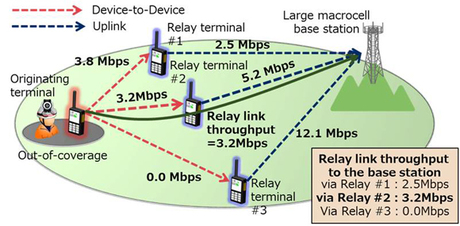Device-to-device communication outside LTE service areas

NEC Corporation has announced the development of device-to-device communication technology that enables emergency response personnel, such as police and firefighters, to transmit high-quality images from the scene of a disaster or accident when outside of the service area of the public safety long-term evolution (PS-LTE) network. Images are essential to enabling authorities to make swift assessments in response to large-scale disasters and in the provision of security for major events.
In LTE networks, if a terminal falls outside of its service area, other terminals may act as relay stations between the isolated terminal and connected base stations. However, when selecting a relay terminal, it has conventionally been difficult to detect the communication route (relay link) that enables the highest quality images. NEC’s technology supports the transmission of these images by enabling terminals outside of the PS-LTE network service area to detect terminals within the service area and then access the network via the terminal that provides the fastest communication with base stations.
The technology was developed using the Relay Link Throughput Estimation Method, which estimates communication throughput based on the quality of wireless communications, taking into account the differences in the resources available for wireless communications as well as modulation/coding schemes, and then integrates the relay link. The communications speed from an isolated terminal cooperating with a relay terminal to connect to a base station can fully be estimated.
The relay terminal estimates the upstream speed and the terminal outside the service area estimates the speed of communications between the terminals. Based on this result, the throughput of the relay link (total communication speed from the terminal to the base station) is calculated and a relay terminal capable of generating the highest speed is selected.
“By utilising this technology, images from large-scale disasters and major accidents can be transmitted via a high-speed LTE network, even when outside of the public safety LTE service area,” said Yuichi Nakamura, general manager, System Platform Research Laboratories, NEC Corporation.
“We believe this technology can contribute substantially to the development of secure and safe infrastructure that reliably supports society.”
NEC tested the technology in a simulated disaster relief scenario where approximately 90% of terminals located indoors, which tend to fall outside of the service area, achieved communications sufficient for the transmission of images. It was presented at Wireless Technology Park 2016, held at Tokyo Big Sight from 25–27 May.
Aussie scientists prove feasibility of Earth-to-space quantum beams
Researchers have shown that it is feasible to send quantum signals from Earth to a satellite,...
New nanomaterial takes shape
Researchers from Flinders University have used used a novel process, known as photostriction, to...
'Liquid metal' composite for greener electronics
A newly developed liquid metal composite material offers a promising solution to the growing...






